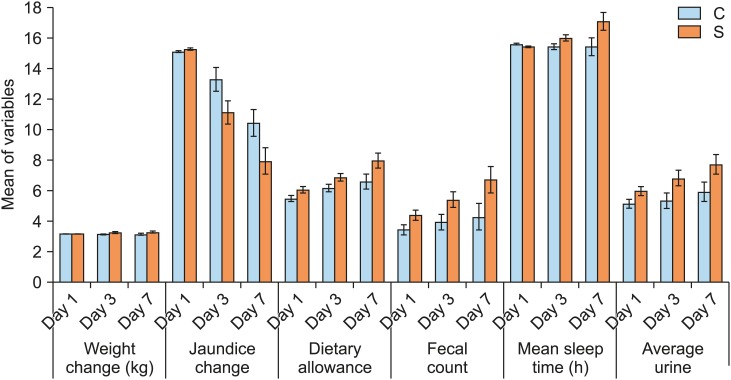1. Alex M, Gallant DP. Toward understanding the connections between infant jaundice and infant feeding. J Pediatr Nur. 2008; 23:429–438.

2. Martin RJ, Fanaroff AA, Walsh WM. Fanaroff and Martin's neonatal perinatal medicine diseases of the fetus and infant. Philadelphia: Mosby;2006.
3. Cohen SM. Jaundice in the full-term newborn. Pediatr Nurs. 2006; 32:202–208. PMID:
16802676.
4. American Academy of Pediatrics Subcommittee on Hyperbilirubinemia. Management of hyperbilirubinemia in the newborn infant 35 or more weeks of gestation. Pediatrics. 2004; 114:297–316. PMID:
15231951.
5. Mahé E, Beauchet A, Aegerter P, Saiag P. Neonatal blue-light phototherapy does not increase nevus count in 9-year-old children. Pediatrics. 2009; 123:e896–e900. PMID:
19403483.
6. McDonagh AF. Bilirubin, copper-porphyrins, and the bronze-baby syndrome. J Pediatr. 2011; 158:160–164. PMID:
20888578.

7. Bhutani VK, Johnson-Hamerman L. The clinical syndrome of bilirubin-induced neurologic dysfunction. Semin Fetal Neonatal Med. 2015; 20:6–13. PMID:
25577653.

8. McDonagh AF, Maisels MJ. Bilirubin unbound: déjà vu all over again? Pediatrics. 2006; 117:523–525. PMID:
16452373.
9. Nag N, Halder S, Chaudhuri R, Adhikary S, Mazumder S. Role of bilirubin as antioxidant in neonatal jaundice and effect of ethanolic extract of sweet lime peel on experimentally induced jaundice in rat. Indian J Biochem Biophys. 2009; 46:73–78. PMID:
19374257.
10. Stanton C, Gardiner G, Meehan H, Collins K, Fitzgerald G, Lynch PB, et al. Market potential for probiotics. Am J Clin Nutr. 2001; 73(2 Suppl):476S–483S. PMID:
11157361.

11. Cummings JH, Macfarlane GT, Macfarlane S. Intestinal bacteria and ulcerative colitis. Curr Issues Intest Microbiol. 2003; 4:9–20. PMID:
12691258.
12. Salminen S, Bouley C, Boutron-Ruault MC, Cummings JH, Franck A, Gibson GR, et al. Functional food science and gastrointestinal physiology and function. Br J Nutr. 1998; 80 Suppl 1:S147–S71. PMID:
9849357.

13. Sur D, Manna B, Niyogi SK, Ramamurthy T, Palit A, Nomoto K, et al. Role of probiotic in preventing acute diarrhoea in children: a community-based, randomized, double-blind placebo-controlled field trial in an urban slum. Epidemiol Infect. 2011; 139:919–926. PMID:
20670468.

14. Prescott SL, Björkstén B. Probiotics for the prevention or treatment of allergic diseases. J Allergy Clin Immunol. 2007; 120:255–262. PMID:
17544096.

15. Hoyos AB. Reduced incidence of necrotizing enterocolitis associated with enteral administration of Lactobacillus acidophilus and Bifidobacterium infantis to neonates in an intensive care unit. Int J Infect Dis. 1999; 3:197–202. PMID:
10575148.

16. Maruo Y, Nishizawa K, Sato H, Sawa H, Shimada M. Prolonged unconjugated hyperbilirubinemia associated with breast milk and mutations of the bilirubin uridine diphosphate- glucuronosyltransferase gene. Pediatrics. 2000; 106:E59. PMID:
11061796.

17. Porter ML, Dennis BL. Hyperbilirubinemia in the term newborn. Am Fam Physician. 2002; 65:599–606. PMID:
11871676.
18. Armanian AM, Barekatain B, Hoseinzadeh M, Salehimehr N. Prebiotics for the management of hyperbilirubinemia in preterm neonates. J Matern Fetal Neonatal Med. 2016; 29:3009–3013. PMID:
26513278.

19. Chen Z, Zhang L, Zeng L, Yang X, Jiang L, Gui G, et al. Probiotics supplementation therapy for pathological neonatal jaundice: a systematic review and meta-analysis. Front Pharmacol. 2017; 8:432. PMID:
28713275.

20. Deshmukh J, Deshmukh M, Patole S. Probiotics for the management of neonatal hyperbilirubinemia: a systematic review of randomized controlled trials. J Matern Fetal Neonatal Med. 2019; 32:154–163. PMID:
28823200.

21. Torkaman M, Afsharpaiman SH, Hoseini MJ, Moradi M, Mazraati A, Amirsalari S, et al. Platelet count and neonatal sepsis: a high prevalence of Enterobacter spp. Singapore Med J. 2009; 50:482–485. PMID:
19495516.
22. Goldin BR, Gorbach SL. The relationship between diet and rat fecal bacterial enzymes implicated in colon cancer. J Natl Cancer Inst. 1976; 57:371–375. PMID:
1003518.
23. Goldin BR, Gorbach SL. Effect of Lactobacillus acidophilus dietary supplements on 1,2-dimethylhydrazine dihydrochloride-induced intestinal cancer in rats. J Natl Cancer Inst. 1980; 64:263–265. PMID:
6766509.
24. Osborn LM, Reiff MI, Bolus R. Jaundice in the full-term neonate. Pediatrics. 1984; 73:520–525. PMID:
6709433.

25. Ahmadipour S, Mohsenzadeh A, Alimadadi H, Salehnia M, Fallahi A. Treating viral diarrhea in children by probiotic and zinc supplements. Pediatr Gastroenterol Hepatol Nutr. 2019; 22:162–170. PMID:
30899692.

26. Preer GL, Philipp BL. Understanding and managing breast milk jaundice. Arch Dis Child Fetal Neonatal Ed. 2011; 96:F461–F466. PMID:
20688866.




